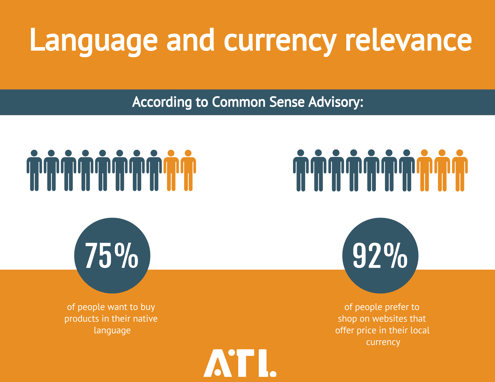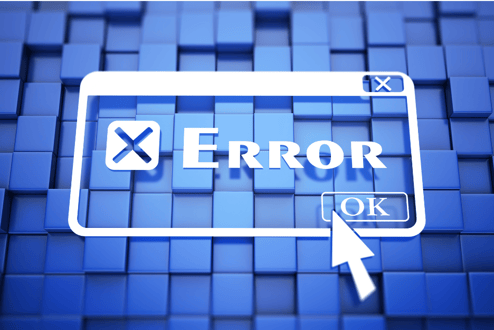
Maintaining your presence on the market year after year is a challenge. Entering new markets is supposed to increase revenue and attract new customers.
If you're reading this, you're likely considering global expansion to take your company to the next level. Everything about it sounds great: less competition, higher ROI, but there's got to be a catch, right?
Well, there is.
It often seems that every business that has a multilingual website in at least 3 languages should be successful in global markets. After all, it's not rocket science.
You create multilingual content for your website, create a few language versions of your landing pages, and call-to-action (CTA) buttons.
That should be simple enough: It's just translation, right?

Localization works, but it's not a piece of cake.
In our 15 years of translating for international clients, we've come across companies that experienced the repercussions of a poor translation that impacted their business.
This article will break down 4 mistakes in business growth caused by a lack of translation, or its poor quality, showing you what it may cost you if you don’t do it right. Or, if you don’t do it at all.
Whether you are thinking about selling online or not, your multilingual website needs to be your online business card.
It's the first place your potential buyers go to for information about you, what services and/or products you offer, and whether your company can provide the solutions to the problems they seek to solve.
Related content: A Guide to Measuring Website Localization ROI
Not having your website translated into the language of your new potential clientele is a global expansion error number one.
Most people living in the market of your choice understand English. Yes, you are right, the rest can use Google Translate to translate all the pages. But is this really the best way to treat your international customers?

Do you really want your unique message to be potentially misunderstood or mistranslated by a machine?
How can you make an emotional connection with your new buyers and show that you understand their issues if you don’t even speak their language?
You don't have to translate all the pages of your website. Product description, forms, and indexed landing pages are a good start. Think about video translation. Your buyers are going to love you for that! You may skip translation of your blog.
In short, when it comes to translating your website, ask yourself the following questions:
Does your translated website provide enough information to help your target audience make a decision?
Are you making an emotional connection with your buyers from the new market?
The answer to these questions should be yes.
If your website isn't delivering information in a local language, your global expansion is unlikely to work for you.
How much will it cost you not to localize your website?
A lot!
Your Customer Acquisition Cost (CAC) will get higher and higher as the budget is allocated, but it will not bring the expected outcome.
Related content: How Much Do Translation Services Really Cost [Rates & Factors]

As already explained, your multilingual website should be your online business card.
As much as we'd like it to be so, inbound marketing results are not immediate. They need to be free of error.
Many businesses want, and expect, cheap translation providers or Machine Translation to provide high quality, top performing marketing translations, SEO localization, video localization, etc. - but this just isn't realistic.
Related content: 5 Ways That Translation Companies Cause You to Overspend
The cost of localization is an investment in your global expansion, and should be treated as such. If you really want to go cheap, make sure to plan extra time and money for the corrections resulting from poor translations.
.jpg?width=430&name=unhappy%20international%20customers%20(1).jpg)
Many business owners really think they understand the necessity of translation when introducing their product on a new market. They hear about it, translate their website and product documentation, and start shipping the products.
They put the products on new market shelves, but after a few months, they don’t see much income.
So, what's the problem?
Translation without taking into account the local requirements is not really localization.
Localization starts with internationalization. The product needs to meet the requirements of the local users, and this means more than just a translated Instruction for Use (IFU).
A product that is a best seller in Spain may not become a high-demand product in Great Britain if you don't make it user-friendly for the British market.
Internationalization means preparing the product and its documentation, so that it's localization-ready.
When it comes to software, internationalization is what makes it flexible with regard to various date and time formats. When it comes to graphics and symbols, it is important to design them as universal as possible.
There are symbols that are inappropriate in some regions, for example the cross, and there are symbols that may be incomprehensible in different cultures. It's crucial to be very careful when choosing symbols for small UI devices.
With regard to the marketing campaigns, internationalization is very strict when it comes to cultural references. These can be local folklore, literature, or geography that will be important in one place, but completely irrelevant in another locale.
.jpg?width=600&name=Multilingual%20website%20(1).jpg)
In order to create content that can be globally used, all sorts of word play or similar culture or language-related concepts should be avoided.
It is not obligatory when it comes to marketing content, as UX urges the use of personal experiences and positive references. It is also based on trends, and temporary sociological surroundings.
Refusing to acknowledge the fact that it is important to design a product or content with localization in mind may lead you to expensive consequences.
Related content: 6 Tips on Preparing Your Content for Translation
How much will this cost you? Let's start with low, or almost no sales in the new market, plus all the production and marketing expenses.
If your translated content addresses the local market in an incorrect, or even offensive way, it will lead to your brand’s reputation being damaged.
When you learn about the local legal requirements before even starting the localization process, you will save more money than when learning them the hard way.
If you want to avoid having your product blocked at the European Union border, make sure that your product meets legal requirements with regard to labels.
If you plan to sell your products in one or more EU countries, you must translate the text in all the official national languages where the products will be available.
If your product contains chemicals, it needs to be accompanied by an SDS (Safety Data Sheets) in the language of the destination country, completed before arrival.
System of Measurement is a collection of units and rules used for measuring things like weight, distance, speed, etc. Different units are used in different parts of the world.

An inch, foot, yard, and mile are completely understood in the USA, but they can’t be used, for example, in France. In France, what you need to use is the metric system, so in this case, millimeters, centimeters, meters and kilometers apply.
The interesting fact from the localization point of view is that it isn't enough to simply translate the unit from the US to metric system. What needs to be done is called conversion. It's exactly the same as with currencies.
If you want to sell in Euro, it isn't enough to change the USD into EUR next to the amount. What you need is the exchange rate.
System of measurement is easier to handle as it does not change, and global issues do not influence the number of millimeters in one inch.
So, when dealing with numbers followed by units, for example with regard to the automotive industry, it is not enough to translate the measurement units. Your content needs the numbers to be localized together with the units, which means they need to be converted.
How much will it cost you if you forget to convert the numbers?
These are only examples of how wrong it can go.
So, forget about proper content localization, and that would be the end of your global expansion. Losing customers is one thing, ruining your reputation is another, but putting your local buyers in danger opens you up to a potential lawsuit.

You already know what can happen when your content is poorly translated, or not translated at all. You are now ready to start translating your content according to localization "best practices".
You just want to wait a little bit for the website to be finalized and let the marketing gurus manually tweak the content here and there.
Or, you want to just wait a bit to make sure that it is really the right time to start localization, because maybe it would be better to wait a little longer.
Or simply, all is set with the localization services provider, but "there is this great deal on Booking.com, so let's give them green light when I get back".
At ATL, we have experienced all of these scenarios and they lead to costly consequences. Unless you know How to Reduce Turnaround Time for Content Translation, you better not wait too long with the green light.
We've seen clients who divided their content between several translation companies that didn't communicate with each other. As a result, the whole translation was inconsistent.
In one part of the content, the product name was translated, and in the other, it was left in English. The client had to pay additional fees for the whole content to be revised and corrected.
We have also seen clients using Machine Translation, which is fast, but can't be used without human post-editing (checking translations done by the machines and correcting them as needed).
Last but not least, we have seen clients pay high rush fees in order to make deadlines before the planned product launch.
Printing the documentation when the products are waiting at the border can be really stressful, i.e., the cost of delay, rush fees, and the cost of errors made in the rush. And on top of all of that, you are allowing your competition to get ahead of you. It all can be avoided by proper localization planning.
Translation software is often called CAT (Computer Assisted Translation or Computer Aided Translation) tools.
There are all sorts of various CAT tools available on the market. You can choose from web-based software, desktop solutions, or a mixture of both. There are even versions for smartphones available.
All CAT tools are very similar and serve the same main purpose - they speed up the translation process and make it cheaper for you.
The most basic feature of all translation tools is that they divide the content in the original language into logical chunks called segments and create a bilingual file.
The sole act of translation is always conducted by a human translator. Everything that has been translated in a document or a project is immediately saved in a database called Translation Memory (TM). The translations saved in the TM can be easily reused at any time.
For example, if your text contains two sentences that differ by only one word, the TM will immediately recognize the already-translated sentence and point out the difference that needs translation.
Not using CAT tools for your content translation may cost you a lot of money. The savings can be as high as 36% of your translation cost when using CAT tools.
Related content: How Does Translation Memory Generate Your Savings [video]
Translation companies that are transparent with regard to pricing, always provide quotes based on CAT analysis.
The analysis includes repetitions and TM matches (fragments that have been translated previously in your projects; if this is your first quote, there won't be any TM matches). All the words that are not "new" qualify for a discount of 25% to 36%.
And, to be clear, it's not you who should own and use CAT tools, it's the translation company. What the company may ask you to do, is to allow integration of their CAT tools with your content repository.
Integrations allow seamless cooperation and content exchange. There is no need for file exchange, storing, and paying attention to renaming subsequent file versions with updates. Everything happens automatically.

An effective content translation demands effective resources. Make sure to choose a localization partner that is the right fit for you. Find a translation company that best suits your localization needs.
Related content: The 15 Best Translation Companies: Are You a Good Fit for Them?
It may be helpful to take these four possible problems concerning content translation into account before venturing into global expansion. As a professional translation provider, we're also here to help you overcome them, and succeed on the global market.
When you invest some of your time by speaking directly to a translation agency about implementing proper localization workflow, you'will see unmatched growth.
If you want results, you have to take content translation seriously, and be prepared for it. Give us a call if you have any questions about how to plan your content translation and implement it for fast and cost-efficient international business growth.
Recommended articles:
How Much Does Website Translation Cost?
Translation Agencies vs. Google Translate Plugin: An Honest Comparison
+1 857 777 5741 ext. 203 (business inquiries)
+1 857 777 5741 ext. 205 (career inquiries)
Trylinskiego 16, 10-683
Olsztyn, Poland
Copyright ATL 2025. All Rights Reserved.